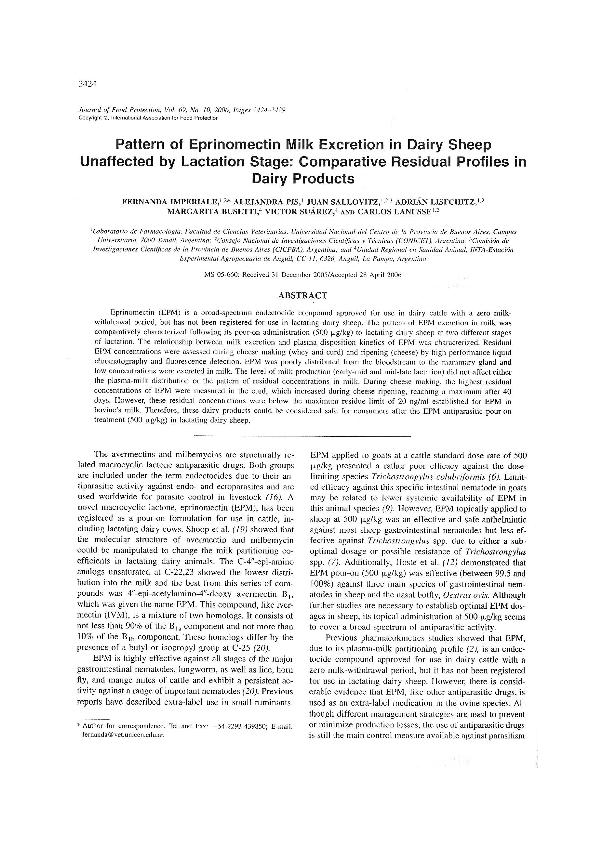Artículo
Pattern of Eprinomectin Milk Excretion in Dairy Sheep Unaffected by Lactation Stage: Comparative Residual Profiles in Dairy Products
Imperiale, Fernanda Andrea ; Pis, Alejandra; Sallovitz, Juan Manuel; Lifschitz, Adrian Luis
; Pis, Alejandra; Sallovitz, Juan Manuel; Lifschitz, Adrian Luis ; Busetti, Margarita Rosa; Suarez, Víctor Humberto; Lanusse, Carlos Edmundo
; Busetti, Margarita Rosa; Suarez, Víctor Humberto; Lanusse, Carlos Edmundo
 ; Pis, Alejandra; Sallovitz, Juan Manuel; Lifschitz, Adrian Luis
; Pis, Alejandra; Sallovitz, Juan Manuel; Lifschitz, Adrian Luis ; Busetti, Margarita Rosa; Suarez, Víctor Humberto; Lanusse, Carlos Edmundo
; Busetti, Margarita Rosa; Suarez, Víctor Humberto; Lanusse, Carlos Edmundo
Fecha de publicación:
10/2006
Editorial:
International Association for Food Protection
Revista:
Journal of Food Protection
ISSN:
0362-028X
e-ISSN:
1944-9097
Idioma:
Inglés
Tipo de recurso:
Artículo publicado
Clasificación temática:
Resumen
Eprinomectin (EPM) is a broad-spectrum endectocide compound approved for use in dairy cattle with a zero milk-withdrawal period, but has not been registered for use in lactating dairy sheep. The pattern of EPM excretion in milk was comparatively characterized following its pour-on administration (500 microg/kg) to lactating dairy sheep at two different stages of lactation. The relationship between milk excretion and plasma disposition kinetics of EPM was characterized. Residual EPM concentrations were assessed during cheese making (whey and curd) and ripening (cheese) by high-performance liquid chromatography and fluorescence detection. EPM was poorly distributed from the bloodstream to the mammary gland and low concentrations were excreted in milk. The level of milk production (early-mid and mid-late lactation) did not affect either the plasma-milk distribution or the pattern of residual concentrations in milk. During cheese making, the highest residual concentrations of EPM were measured in the curd, which increased during cheese ripening, reaching a maximum after 40 days. However, these residual concentrations were below the maximum residue limit of 20 ng/ml established for EPM in bovine´s milk. Therefore, these dairy products could be considered safe for consumers after the EPM antiparasitic pour-on treatment (500 microg/kg) in lactating dairy sheep.
Palabras clave:
EPRINOMECTIN
,
DAIRY CATTLE
Archivos asociados
Licencia
Identificadores
Colecciones
Articulos(CIVETAN)
Articulos de CENTRO DE INVESTIGACION VETERINARIA DE TANDIL
Articulos de CENTRO DE INVESTIGACION VETERINARIA DE TANDIL
Citación
Imperiale, Fernanda Andrea; Pis, Alejandra; Sallovitz, Juan Manuel; Lifschitz, Adrian Luis; Busetti, Margarita Rosa; et al.; Pattern of Eprinomectin Milk Excretion in Dairy Sheep Unaffected by Lactation Stage: Comparative Residual Profiles in Dairy Products; International Association for Food Protection; Journal of Food Protection; 69; 10; 10-2006; 2424-2429
Compartir
Altmétricas



